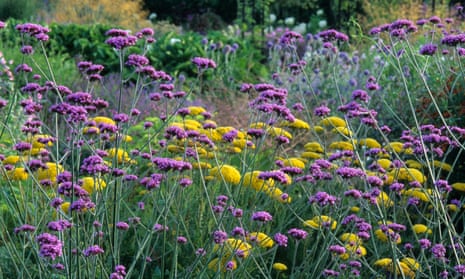It sometimes seems that every car park, roundabout, back garden or park is smattered with Verbena bonariensis. It is not a “designer” plant any more – that ship sailed long ago – but it fits in effortlessly wherever it is added. So I guess I am advocating even more to please the butterflies.
The Guardian’s product and service reviews are independent and are in no way influenced by any advertiser or commercial initiative. We will earn a commission from the retailer if you buy something through an affiliate link. Learn more.
V. bonariensis has captured our garden hearts because it can also thread together a scheme, add height without too much distraction, please pollinators and flower well into autumn. It will self-seed, particularly if you give it a free-draining substrate; it loves cracks in paving and gravel gardens. Although it’s a short-lived perennial, if the conditions are right, it will seed itself just as the parent plant is giving up the ghost.
However, if the winter is mild, the plants often go from sturdy lofty things to rather haphazard and shrubby as they resprout in spring. In a wilder space this might not be much of an issue, but in smaller spaces it needs to stand strong, otherwise it looks a mess.
The simplest way round this is to take cuttings. With the average container growing plant being about £4, it saves money, too. Cuttings taken now will require somewhere frost-free over winter, but it’s easy enough to house a dozen or so if the winter is brutal. My cuttings will spend their winter by my back door, the lee of the house being protection enough. If frost threatens, I’ll put a propagator lid and fleece over them.
Taking cuttings is simple. Choose a non-flowering shoot; often the best are side shoots that are 5-10cm long. Snip them off with secateurs or sharp scissors just below a set of leaves. Remove this lower set of leaves and insert the cutting into gritty compost around the edge of a pot. If you can offer bottom heat from an electric propagator, this will guarantee quick rooting, but it’s not necessary at this time of year; in a month, though, it’ll be more so.
When you see roots coming out of the bottom of the pot, it’s time to pot them individually. Keep them somewhere bright and protected, until you can plant them out next spring.
You can take cuttings of any verbena right now and there’s more on offer than just V. bonariensis. If all that height is not what you are looking for, try V. rigida, which reaches 30cm tall and looks similar to V. bonariensis but with more vibrant flowers. It works well on rooftops, in containers and on balconies, because it’s a tough little plant and often keeps flowering into November. If you are looking for something a little more restrained, ‘Polaris’ is a very pale purple-grey.
Finally, V. hastata is still underused. It grows to 20-30cm tall and has a more tapered, stiffly erect habit with pale pink flowers. V. hastata ‘Alba’ has white flowers and a lovely autumn colour. Like the other verbenas, by late winter the seed heads turn jet black and look most arresting.

Comments (…)
Sign in or create your Guardian account to join the discussion